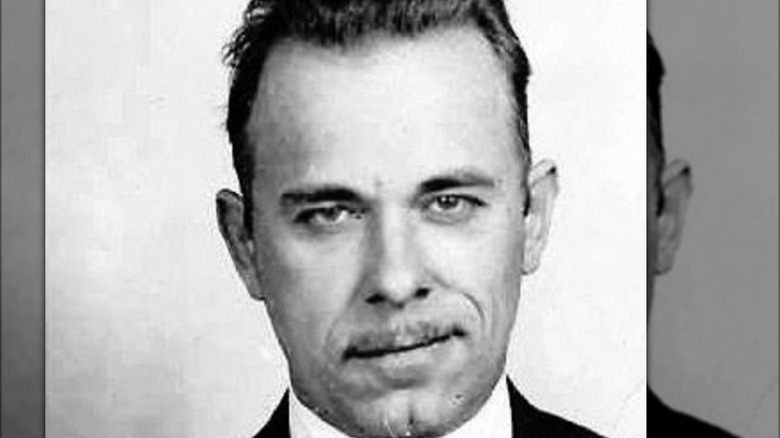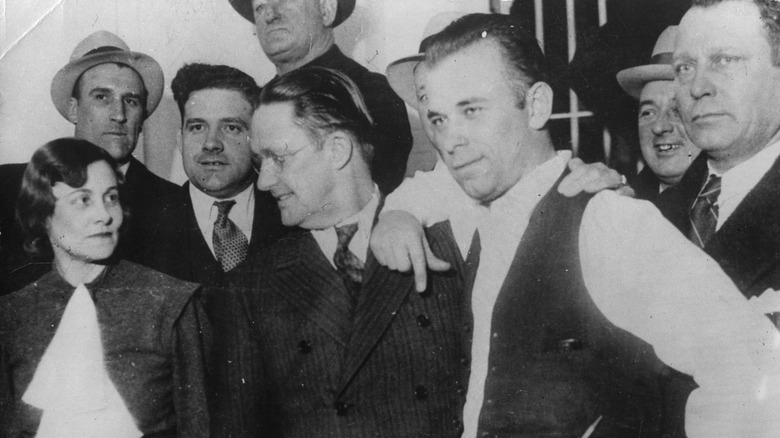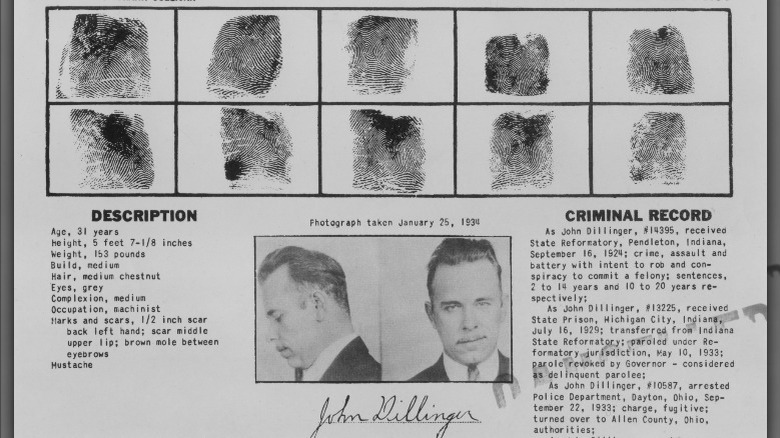Disturbing Details About John Dillinger's Autopsy Report
John Dillinger was one of the most notorious criminals during the Great Depression — a time of widespread poverty and unemployment that pushed people to commit criminal acts, such as robbery, prostitution, and bootlegging. Dillinger was born in Indianapolis, Indiana, and he experienced difficulties in life at an early age. His mother died when he was just 3 years old, and he did not have the best relationship with his stepmother. According to Biography, Dillinger committed petty theft as a boy and he was part of a gang called the Dirty Dozen. He carried his behavior as he went into his teens, and he dropped out of school, as he wanted to start earning his own money.
In 1923, when Dillinger was 20 years old, he stole a vehicle and was placed under arrest but he was able to escape the authorities. He knew that he couldn't go back to his home, so he joined the U.S. Navy as an escape plan. He finished basic training but soon realized that the discipline and strict rules weren't for him. It was five months into his assignment when he jumped ship and was dishonorably discharged as a result. Per the FBI, Dillinger had difficulty getting a job soon after leaving the Navy, which led him to go back to his life of crime, which escalated as he got older.
John Dillinger's death
John Dillinger was serving his sentence for assault and robbery at the Indiana State Prison when he was released on parole after only eight years into his sentence of a maximum of 20 years in prison. Life behind bars didn't deter Dillinger from committing crimes, and he robbed a bank soon after his release. He was apprehended a couple of times but was able to escape prison, and that was when he and his gang pulled a string of bank robberies, as reported by the FBI. The gang would case out banks and prepared their movements with maps and landmarks, even going as far as killing anyone who got in the way (via PBS). To avoid detection, Dillinger and another gang member underwent plastic surgery in 1934 and soon after, the authorities declared him "Public Enemy No. 1".
In July 1934, a friend of Dillinger's tipped the authorities of his whereabouts in exchange for leniency in her own case. According to History, the felon was exiting the Biograph Theatre in Chicago when FBI agents ordered him to surrender, but he ran and was shot dead. Reports indicated that the agents had cause to shoot, as Dillinger had used his gun, and two civilians were wounded as a result. There were rumors that Dillinger was not the one who was killed in the shootout, as the dead individual's physical appearance had differences from Dillinger's. However, it was known that he went through great lengths to conceal his identity, and even used acid on his fingers to remove his fingerprints.
The results of the autopsy
An autopsy on John Dillinger's body was performed a day after his death. However, the autopsy report had gone missing for 50 years before it was found at the Cook County Medical Examiner's office inside a brown paper bag in 1984. According to the Indianapolis Star, the body had a height of 5 feet, 7 inches and was 150 pounds, which matched the information on Dillinger's driver's license. He sustained four bullet wounds from the shootout — three of which were superficial. The fourth one, however, went through his face and lacerated his neck tissues. Several scars from his previous injuries were also observed, including those on his thighs and legs.
There was a discrepancy in Dillinger's eye color, as it was listed as brown on the autopsy report, but his records from the Navy described them as blue. However, Cook County Medical Examiner Dr. Robert Stein said, per UPI, that it was inconsequential, as the eyes tend to change appearance after death because of "clouding of the cornea." The report further noted that his last meal consisted of meat and vegetables. There were reports that the body was unrecognizable when it arrived at the morgue, but Jeff Scalf, Dillinger's great-nephew, confirmed that it was, in fact, Dillinger's body. "It was rushed. It was very hectic that night. John was a legendary figure, and so I think there were some mistakes made. When I was younger, I wanted to believe that he got away, that it wasn't him, but it was him," Scalf said, per ABC Chicago.


